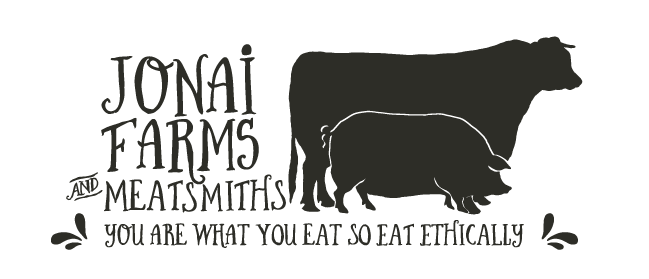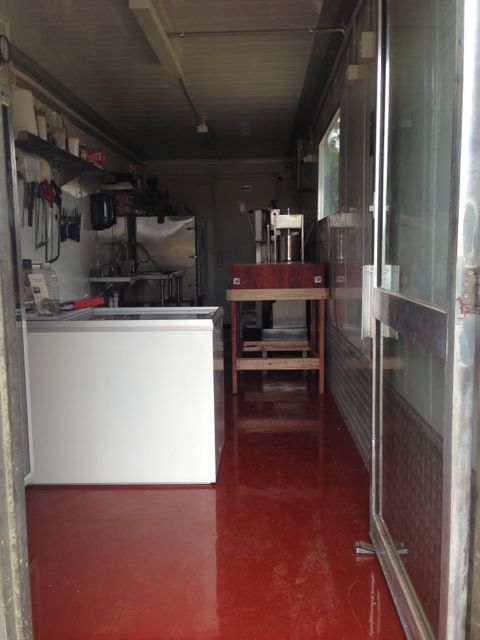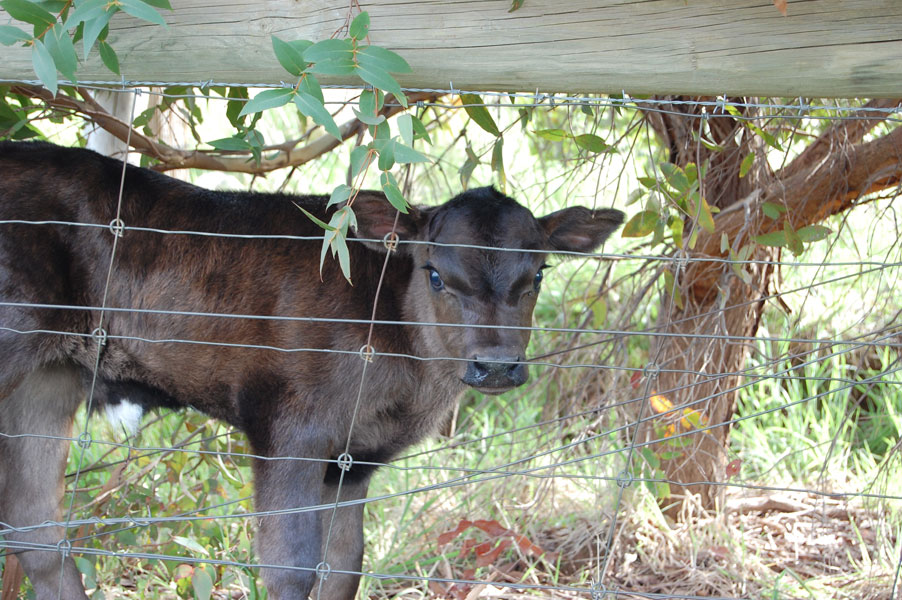If there’s one thing we’ve learned in three years of farming, it’s that for us happiness is hard work. That is, working hard makes us really really happy.
Happiness doesn’t come in the little indulgences used to tolerate one’s day-to-day life, it comes with rejoicing in daily life. It doesn’t come with so-called leisure time in front of a tv, it comes with making things with bare hands, including dinner made from animals we’ve grown, butchered and prepared for the family meal every night.
What some see as drudgery, we celebrate as small achievements, from weeding the garden (yay more room to grow beautiful food!) to building a fence (yay more paddocks to keep the happy piggehs safe & out of mischief!) to chopping vegetables for an hour (yay more beautiful food!).
Competence is happiness. Relationships are happiness. Kindness and caring for others is happiness. Knowledge is happiness. Food you grow yourself offers a greater quotient of happiness than that bought down the street – though of course thoughtfully-made, fresh, seasonal food brings its own kind of happiness wherever you find it.
I haven’t had a single case of ennui since we rolled up this driveway three years ago today, wheelbarrow on the roof and romantic visions of our new life so bright they made our eyes water. The romance is alive and well, and certainly more mature – there’s happiness in every glorious sunrise, but so there is in the hard-earned strength of this meatsmith’s forearms.
I wasn’t planning to write about happiness today – I was going to write about what we’ve learned in the past three years. But there it is – everything we’ve learned comes back to happiness. Learning new skills and knowledge is joyful. Being competent is gobsmackingly good for one’s self esteem. And focusing on others – be it children, animals in the paddocks, or the many families we help feed with our farming efforts – is utterly more satisfying than focusing overmuch on oneself. Big skies are also really life affirming. :-)
Over a typical Jonai farm brekky of poached eggs & farmstead bacon with Tammindaise this morning I asked Stuart what he’s learned in the past three years, and he offered these nuggets:
- Community is essential to a farming enterprise – we give thanks for the Ciderhouse Stringband playing at our salami days, for Turk making my butcher’s block and our beautiful dining table, for Morris dragging the farm ute out of the bog with his tractor so many times that first winter, for the stream of hard-working WWOOFers with whom we’ve been blessed, and for the many neighbours, friends and family who have helped us build, fence, garden, and look after animals so we can get away sometimes
- Relationships are more valuable than economic transactions
- The quality of life up here cannot be compared with our former urban lives
- Managing soil and water health and availability across seasons is a tough gig – and critically important to everything
- Constant work and problem solving is a very creative environment – so many ideas, so little time!
- Caring for animals is an emotional rollercoaster – such joys and sadnesses in life and death on the farm
- The best farming texts are all pre-1950s
He also offered some concrete skills he’s learned:
- Fencing!
- How to move a shipping container with a 4WD and half a dozen fence posts (TJ - we’re so old school we’re practically Egyptian) ;-)
- How to fix anything with a pair of pliers, a couple bits of wire, and a knife velcro’d to the back of your iPhone (Stuart calls it his new app)
Then I asked myself what I’ve learned. As well as ticking all the boxes on Stuart’s list (except I leave my knives in the boning room), here’s what I came up with:
- Practising what I preach is essential for me to offer honest, knowledgeable advocacy for sustainable, ethical agriculture
- Our rural community has an abundance of smart, kind, creative, hard-working, and helpful people for whom I am deeply grateful – our lives are the richer for all of you
- WWOOFers are awesome and can teach you as much as you teach them, whether it’s new skills, knowledge or just a brilliant attitude towards life
- I really really like dogs
- Big skies and wide horizons are salve for the happiest or the saddest soul
- Working in a partnership is an excellent way to see each other’s strengths on a daily basis, which helps soften one’s view of the weaknesses – also how to play to each of our strengths & play down the weaknesses
- Raising kids on the land offers them freedom, responsibility, and daily pleasures that I hope will help them grow up as grounded and appreciative of natural cycles as it did me
- Farming really is a seven-day-a-week job (though we've introduced Make-a-Day on Sundays...), but the rewards are greater than any 40-hour week I ever worked, and being able to set our own priorities (animals and weather willing…) helps make the workload less onerous
- Physical work is bone-deep satisfying, and creates an excellent balance for time spent at a computer to run the business and write all the things – everything’s good when there’s not too much of one thing
- Recipe development out in the boning room for seasonal single-estate and single-region sausages is fun, rewarding, and generally has uncommonly delicious results
- Giving up a PhD to focus on farming, butchering, and fair food advocacy is one of the best difficult decisions I’ve ever made
- For some people going for a run is the best way to clear the head – for me it’s putting my hands in soil – weeding, planting, harvesting…
- Pigs are quite smart, but no, they’re not as smart as a three-year-old child
- Joel Salatin was right - if you control your supply chain and sell everything directly, you really can run a profitable small farm
- A lot of things in life are rather daunting – be dauntless!
And my concrete learnings:
- Pigs build enormous nests like a bird when they’re due to farrow (give birth) – it’s a natural instinct to keep their piglets safe from weather and squashing
- Raising pigs (or poultry or any animal) intensively, especially indoors, is truly, utterly unnecessary and in my view cruel. We’ve now raised our animals outdoors for three years and have been inside an intensive piggery and cannot under any circumstances agree with the justifications for those systems – the stench alone is almost unbearable for both humans and the pigs. Our pigs are healthy (free of respiratory ailments and infections from chewing each other’s tails common in intensive piggeries), farrow well outdoors year round with constant access to huts, and never show signs of stress or aggression such as tail biting.
- If you don’t strain a fence properly with well-braced wooden posts it will sag & taunt you with a day’s wasted efforts – as my dad always said, ‘if a thing’s worth doing, it’s worth doing well’
- There’s a season for everything, including fencing – once the ground dries up it’s all over rover, so get your fencing done by springtime
- Insulated gum boots are amazing
- You can indeed have a wooden butcher’s block in a licensed butcher’s shop
- I can transform an entire pig carcass into an array of excellent cuts in an hour and a half. A side of beef takes me about five hours now (remember the first steer that took me three days?!)
- If you do meat workshops in your shed, you cannot legally let anybody take any of the meat home – doesn’t matter whether you’re a licensed butcher or not, if the shed isn’t licensed, it’s illegal. But it’s legal to eat anything you make onsite
- You cannot cryovac ham (or any other ready-to-eat product) unless you have in place a Listeria Management Plan, which in Victoria involves monthly swab testing and quarterly product testing (after an initial three months of fortnightly testing)
- The longer you slow cook muscle meat (pork shoulder, beef blade, chuck, brisket…) the better. If the recipe says at least two hours aim for at least four.
- Curing meat is not in fact a dark art, and once you crack the code, you can cure anything. It’s just meat, salt & time.
- Patience tastes delicious.
There really are opportunities to live a great life farming, and I encourage anyone considering the move to go for it. We need more farmers, not less – lots of small farmers like us out here on the land maintaining and creating vibrant rural communities and growing food that’s fair from soil to stomach.
I salute my fellow farmers across Australia and the world – you’re amazing, and I’m honoured (and ecstatic!) to be one of you. Here’s to the next three years of hard-working happiness!






